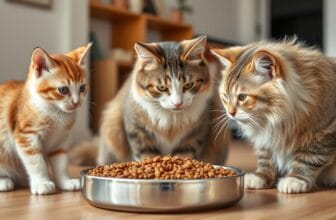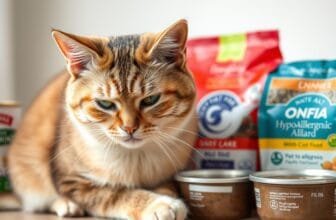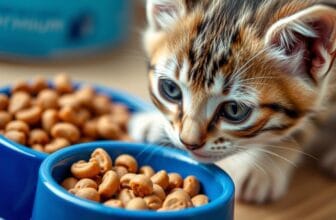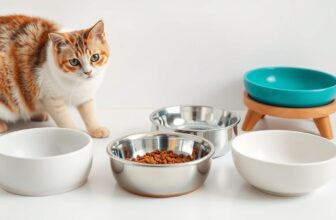
Why Choose Organic and Natural Cat Food?
Cats are obligate carnivores requiring diets rich in animal protein. Organic and natural cat food brands typically offer higher-quality ingredients with fewer fillers, artificial preservatives, and questionable by-products than conventional options.
Benefits of Organic Cat Food
- Higher-quality protein sources from animals raised without antibiotics or hormones
- Free from artificial colors, flavors, and preservatives
- Reduced exposure to pesticides and synthetic fertilizers
- Often includes omega-3 fatty acids for coat and skin health
- Typically contains fewer fillers and more digestible ingredients
- May reduce allergic reactions in sensitive cats
Considerations
- Higher price point than conventional cat food
- May require gradual transition to prevent digestive upset
- Not all “natural” labels meet the same standards
- Some cats may be resistant to dietary changes
- Requires research to verify legitimate certifications
What to Look for in Organic and Natural Cat Food

Important Certifications
When evaluating organic and natural cat food brands, look for these key certifications:
- USDA Organic: Ingredients are grown without synthetic fertilizers, pesticides, or GMOs. Animal ingredients come from animals raised on organic feed without antibiotics or hormones.
- Non-GMO Project Verified: Ingredients have been verified to contain no genetically modified organisms.
- AAFCO Statement: Confirms the food meets the nutritional standards established by the Association of American Feed Control Officials.
- Human-Grade: Ingredients and processing facilities meet human food production standards.
Key Ingredients to Prioritize
Quality organic and natural cat food brands typically feature:
- Named animal protein sources: Look for specific proteins like “organic chicken” rather than generic “meat” or “poultry”
- Whole food ingredients: Recognizable vegetables and fruits rather than by-products
- Essential fatty acids: Omega-3 and omega-6 fatty acids for skin and coat health
- Limited carbohydrates: Cats have limited ability to digest carbohydrates
- No artificial preservatives: Natural preservatives like mixed tocopherols (vitamin E) instead of BHA, BHT, or ethoxyquin
Ingredients to Avoid
Even some “natural” cat foods may contain less desirable ingredients:
- Meat by-products: Unspecified animal parts of questionable quality
- Artificial colors and flavors: Unnecessary additives with potential health concerns
- Carrageenan: A thickening agent linked to digestive inflammation
- Excessive plant proteins: Cats need animal-based protein sources
- Chemical preservatives: BHA, BHT, and ethoxyquin have been linked to health issues
Top Organic and Natural Cat Food Brands Compared

| Brand | Certifications | Protein Sources | Grain Status | Price Range (per lb) |
| Tender & True | USDA Organic, Non-GMO | Chicken, Turkey, Fish | Both options available | $7.50-$9.00 |
| Castor & Pollux Organix | USDA Organic | Chicken, Turkey, Fish | Both options available | $6.75-$8.50 |
| Open Farm | Certified Humane, Ocean Wise | Chicken, Turkey, Fish, Beef | Grain-free | $8.00-$10.00 |
| Gather by Petcurean | Certified Organic | Chicken, Fish | Both options available | $7.00-$8.50 |
| Hound & Gatos | Natural, Grain-Free | Chicken, Turkey, Rabbit, Lamb | Grain-free | $6.50-$8.00 |
| Weruva | Human-Grade | Chicken, Fish, Beef | Mostly grain-free | $7.00-$9.50 |
| Primal Pet Foods | Raw, Natural | Chicken, Turkey, Beef, Venison | Grain-free | $14.00-$18.00 |
| Evanger’s Organics | USDA Organic | Chicken, Turkey | Grain-free | $5.50-$7.00 |
| Newman’s Own Organic | USDA Organic | Chicken, Turkey | Contains grains | $5.00-$6.50 |
| Koha | Limited Ingredient, Natural | Chicken, Duck, Fish, Lamb | Grain-free | $6.00-$8.00 |
Best Overall Organic Cat Food

Tender & True Organic Chicken & Liver Recipe
Tender & True stands out as our top overall pick among organic and natural cat food brands for its exceptional ingredient quality and comprehensive certifications. This brand offers both wet and dry food options with USDA Organic certification, ensuring ingredients meet strict standards.
Key Features:
- USDA Certified Organic chicken as the first ingredient
- Organic chicken liver provides essential nutrients
- No artificial preservatives, colors, or flavors
- Available in both grain-free and grain-inclusive formulas
- Contains omega-3 fatty acids for skin and coat health
Nutritional Analysis:
With approximately 32% protein and 15% fat in the dry formula, Tender & True provides excellent nutrition for adult cats. The wet food options contain even higher protein percentages (40-45% on a dry matter basis), making them an excellent choice for obligate carnivores. The limited ingredient list minimizes potential allergens while providing complete nutrition.
Most Affordable Organic Cat Food

Newman’s Own Organic Cat Food
For cat parents seeking organic nutrition on a budget, Newman’s Own Organic offers excellent value without compromising on quality. As one of the more affordable organic and natural cat food brands, it provides a accessible entry point into premium nutrition.
Key Features:
- USDA Certified Organic ingredients
- No artificial preservatives, colors, or flavors
- Organic chicken as the primary protein source
- Contains organic grains for digestible carbohydrates
- Company profits go to charity
Nutritional Analysis:
Newman’s Own Organic provides approximately 30% protein and 12% fat in their dry formulas, meeting AAFCO standards for adult cat maintenance. While not grain-free, the organic grains used are more digestible than conventional alternatives. The formula includes essential vitamins, minerals, and taurine for complete nutrition at a more accessible price point than many competitors.
Best for Sensitive Stomachs

Koha Limited Ingredient Diet
Cats with sensitive stomachs or food allergies need specially formulated nutrition. Koha’s Limited Ingredient Diet stands out among organic and natural cat food brands for its digestive-friendly formulation and high-quality protein sources.
Key Features:
- Single-source animal protein (options include duck, lamb, turkey, or fish)
- Limited ingredient list minimizes potential allergens
- Grain-free formulation
- No artificial preservatives, colors, or flavors
- Added pumpkin for digestive support
- High moisture content in wet food varieties
Nutritional Analysis:
Koha’s Limited Ingredient Diet provides approximately 8-10% protein in wet formulas (approximately 40-45% on a dry matter basis), making it highly digestible for sensitive cats. The simplified ingredient list eliminates common allergens while still providing complete nutrition. The high moisture content in the pâté formulas supports urinary health and hydration, particularly important for cats with digestive sensitivities.
Best Wet Organic Cat Food

Weruva Paw Lickin’ Chicken
Wet food provides essential hydration for cats, and Weruva stands out among organic and natural cat food brands for its exceptional moisture content and human-grade ingredients. Their Paw Lickin’ Chicken formula offers visible quality you can see.
Key Features:
- Human-grade chicken as the primary ingredient
- Visible, shredded meat texture cats love
- 85% moisture content supports hydration
- Free from carrageenan, BPA, and artificial additives
- Minimal carbohydrate content
- Produced in human food facilities
Nutritional Analysis:
Weruva’s wet formulas contain approximately 10% protein and 1.4% fat as fed (approximately 50% protein and 7% fat on a dry matter basis), making them excellent for obligate carnivores. The high moisture content supports urinary tract health, while the minimal carbohydrate content aligns with cats’ natural dietary needs. The texture of real, shredded chicken appeals to even picky eaters.
Best Dry Organic Cat Food

Open Farm Wild-Caught Salmon
For cat parents who prefer dry food, Open Farm offers exceptional quality among organic and natural cat food brands. Their Wild-Caught Salmon recipe combines ethically sourced protein with sustainable practices for a premium kibble option.
Key Features:
- Ocean Wise certified sustainable wild-caught salmon
- Humanely raised protein sources
- No artificial preservatives, colors, or flavors
- Transparent sourcing with traceable ingredients
- Rich in omega-3 fatty acids for skin and coat health
- Non-GMO fruits and vegetables
Nutritional Analysis:
Open Farm’s dry formulas provide approximately 33% protein and 18% fat, exceeding AAFCO standards for adult cats. While the carbohydrate content is higher than wet food alternatives (approximately 30% on a dry matter basis), the quality of ingredients is exceptional. The inclusion of salmon oil provides essential omega-3 fatty acids, while probiotics support digestive health.
Best Grain-Free Organic Options

While cats don’t necessarily need grain-free diets, some pet parents prefer these formulations. Among organic and natural cat food brands offering grain-free options, these stand out for their quality:
Castor & Pollux Organix Grain-Free
USDA Certified Organic ingredients with organic free-range chicken as the first ingredient. Contains organic peas and potatoes instead of grains.
Hound & Gatos Grain-Free
98% animal protein formula with no plant proteins, grains, or artificial ingredients. Available in multiple protein options including rabbit and lamb.
Gather Free Acres by Petcurean
Features certified organic free-run chicken with organic peas. Certified organic ingredients with sustainable packaging.
Best Raw and Freeze-Dried Organic Options

Raw and freeze-dried options provide minimally processed nutrition that closely mimics a cat’s natural diet. These organic and natural cat food brands offer excellent raw options:
Primal Pet Foods Freeze-Dried
Made with antibiotic-free chicken and organic produce. The freeze-drying process preserves nutrients without cooking while eliminating pathogens.
Stella & Chewy’s Freeze-Dried Raw
Contains 98% cage-free poultry, responsibly sourced fish, and organic fruits and vegetables. Available in multiple protein options.
Feline Natural Freeze-Dried
Made with grass-fed, free-range meat and sustainably caught fish. Contains no grain, gluten, GMO ingredients, artificial preservatives, or additives.
Buyer’s Guide: Transitioning to Organic Cat Food

Transitioning your cat to organic and natural cat food brands requires patience and careful monitoring. Follow these steps for a smooth transition:
- Consult your veterinarian before making any dietary changes, especially for cats with existing health conditions.
- Plan a gradual transition over 7-10 days to prevent digestive upset.
- Start with 25% new food mixed with 75% old food for the first 2-3 days.
- Increase to 50% new food and 50% old food for the next 2-3 days.
- Move to 75% new food and 25% old food for another 2-3 days.
- Complete the transition to 100% new food if your cat shows no signs of digestive upset.
- Monitor for any adverse reactions such as vomiting, diarrhea, or refusal to eat.
Tip: If your cat is particularly finicky, try warming wet food slightly or adding a small amount of nutritional yeast (not brewer’s yeast) as a flavor enhancer during the transition period.
Common Challenges When Transitioning
Food Refusal
Some cats are naturally resistant to dietary changes. If your cat refuses the new food:
- Try a different protein source or texture
- Mix a very small amount of new food with their favorite food
- Gradually increase the new food ratio over a longer period
- Ensure food is at room temperature
Digestive Upset
If your cat experiences digestive issues during transition:
- Slow down the transition process
- Temporarily revert to the previous ratio that didn’t cause problems
- Consider adding a probiotic formulated for cats
- Try a limited ingredient formula for sensitive stomachs
Frequently Asked Questions About Organic Cat Food

Is organic cat food worth the higher price?
For many cat parents, the benefits of organic and natural cat food brands justify the higher cost. Organic foods typically contain higher-quality ingredients without synthetic pesticides, hormones, or antibiotics. They often have fewer fillers and more digestible protein sources, which can lead to better long-term health, potentially reducing veterinary costs over time. However, the value depends on your budget and your cat’s specific health needs.
What’s the difference between “natural” and “organic” cat food?
“Organic” is a regulated term requiring certification and compliance with specific standards for ingredient sourcing and processing. Ingredients must be grown without synthetic pesticides, GMOs, or chemical fertilizers, and animal ingredients must come from animals raised without antibiotics or hormones.
“Natural” is less regulated and generally means the product contains no artificial colors, flavors, or preservatives, but ingredients may still be conventionally grown or raised. When comparing organic and natural cat food brands, look for specific certifications rather than marketing terms.
Is grain-free better for cats?
Not necessarily. While cats are obligate carnivores requiring primarily animal protein, some can digest small amounts of grains without issues. The quality of ingredients matters more than whether a food contains grains. Some grain-free foods substitute with potatoes or legumes, which aren’t necessarily better for cats.
Unless your cat has a specific grain allergy or sensitivity, choosing high-quality organic and natural cat food brands with excellent protein sources should be the priority, whether grain-free or grain-inclusive.
How do I know if my cat is allergic to their food?
Common signs of food allergies in cats include:
- Excessive scratching or grooming
- Skin irritation, redness, or rashes
- Recurrent ear infections
- Gastrointestinal issues (vomiting, diarrhea)
- Hair loss
If you suspect a food allergy, consult your veterinarian. They may recommend an elimination diet using limited ingredient organic and natural cat food brands to identify the allergen.
Should I feed my cat wet food, dry food, or both?
Many veterinarians recommend feeding cats primarily wet food or a combination of wet and dry food. Wet food provides essential moisture that supports urinary tract health, as cats naturally have a low thirst drive. Dry food can help with dental health and offers convenience.
The best approach often combines high-quality organic and natural cat food brands in both wet and dry forms, with wet food making up the majority of the diet. This provides balanced nutrition while ensuring adequate hydration.
Conclusion: Choosing the Best Organic Cat Food
When selecting among organic and natural cat food brands, prioritize products with high-quality animal proteins, minimal processing, and transparent sourcing. Consider your cat’s individual needs, preferences, and any health conditions when making your choice.
Our top overall recommendation is Tender & True Organic for its exceptional ingredient quality and comprehensive certifications. For budget-conscious pet parents, Newman’s Own Organic offers excellent value, while Koha Limited Ingredient Diet provides specialized nutrition for cats with sensitivities.
Remember that the best food is one that meets your cat’s nutritional needs and that they’ll actually eat. Monitor your cat’s health, weight, and energy levels after transitioning to ensure the new diet is working well for them.
Ready to upgrade your cat’s nutrition?
Try our top-rated organic cat food pick and see the difference quality nutrition can make for your feline friend.







